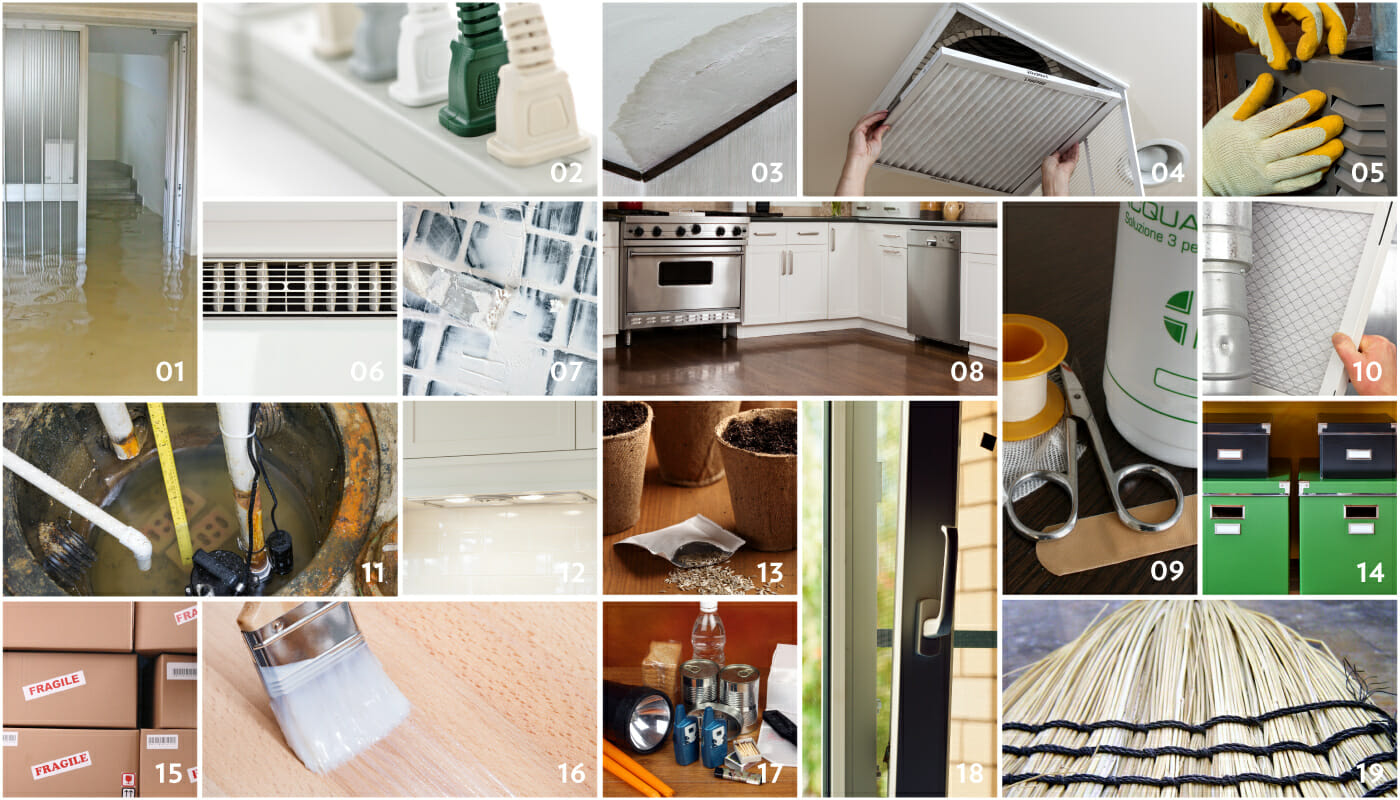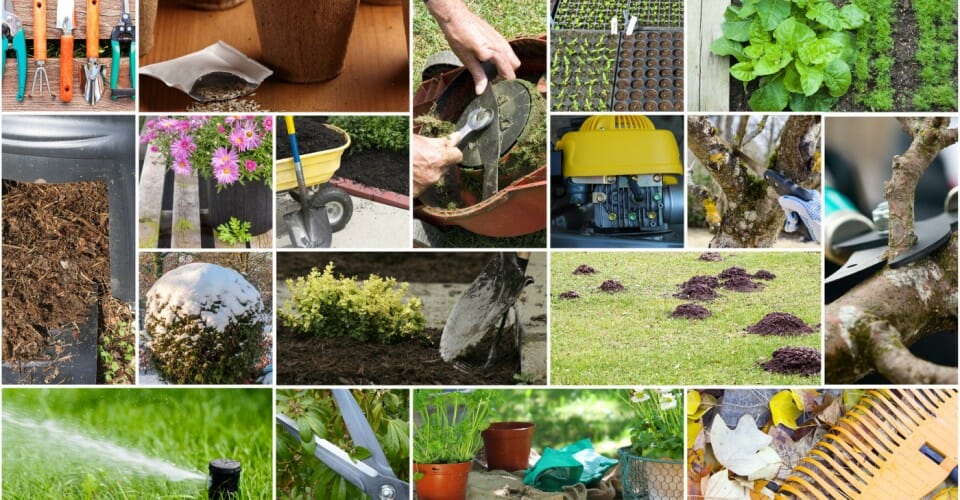Read your monthly maintenance tips here plus helpful links and project information.
The official date of spring is March 20th and winter is slowly losing its bite. For homeowners in mild to moderate climates, March is the time for stepping out into the yard, inspecting the property for winter damage, and preparing for spring. Other regions may still be still under a blanket of frost and snow, waiting for the thaw to begin later this month. Flooding is a general problem for many states, as warmer evening temperatures slowly thaw frozen ground. Spring may also be the time for electrical storms and heavy rains. Regardless of your specific regional climate and temperatures, here are some maintenance and preventative tips every homeowner should be aware of this month.

Interior Home Maintenance Guide
1. Prepare for potential floods: elevate electrical items (DIY)
2. Plug all electronics into surge protectors to prepare for lightning storms (DIY)
3. Check/replace air conditioning filters (HVAC)
4. Have your HVAC system inspected at least once a year (HVAC)
5. Clean air ducts if necessary (HVAC)
6. Clean and reseal tile grout as necessary (DIY, Tile Installer, Handyman)
7. Clean under heavy appliances (refrigerator, dishwasher, etc.) (DIY, Housecleaner)
8. Update first aid kit (DIY)
9. Clean range hood filters: wash fan blades and housing (DIY, Housecleaner)
10. Start planting seeds for indoor plants (DIY)
11. De-clutter your home: focus on desks, closets, office spaces, etc. (DIY, Professional Organizer, Interior Designer)
12. Clean out the attic and basement (DIY, Professional Organizer)
13. Check your sub pump for proper operation (Basement Waterproofing Contractor, Plumber)
14. Inspect basement and attic for any dampness (Foundation Contractor, Attic Insulation)
15. Add waterproof veneer to basement/exterior walls (Basement Waterproofing Contractor, Foundation Specialist)
16. Prepare an emergency kit with flashlights, food & water (DIY, Professional Organizer)
17. Take down storm windows and install original screens (DIY, Handyman, Window Installer)
18. Sweep garage floor (DIY, Housecleaner)

Exterior Home Maintenance Guide
1. Put out water, seeds, and suet for birds. (DIY)
2. Locate & remove early signs of birds/insect nests (DIY, Animal Removal Specialist, Pest Control)
3. Look for rotting wood/peeling paint along the eaves, Examine siding for signs of winter damage (Siding Contractor)
4. Replace storm windows with original screens (Window Installer, Handyman)
5. Clean gutters: clear any blockages, leaves or branches (Gutter Specialist)
6. Call a chimney sweep for maintenance after the winter season (Professional Chimney Sweep)
7. Clean gutters of trapped ice and frozen debris (Gutter Specialist)
8. Inspect & clean outdoor light fixtures (DIY, Electrician)

Landscaping Home Maintenance Guide
March is the perfect time to get out into the yard and preparing for spring planting of annuals and tending to your perennials and fruit-bearing trees. Seedlings planted in January and February can often be planted in the ground in March, or they may be placed in a greenhouse. Some plants and shrubs should also be pruned at this time. If you’re regular gardener, you’re most likely familiar with the phrase “Plant Hardiness Zone.” This zone map, defined by the USDA, is based on the average annual minimum winter temperature. The zones, divided by numbers 1 – 13, help gardeners determine which plants will thrive in which locations. For example, homeowners living in zone 2 may have success with certain types of vegetation that are quite different from a homeowner living in zone 9. Because landscaping projects usually involve planting and caring for your plants, trees and shrubs, it’s best to start with your zone when figuring out which projects to focus on. We’ve listed general landscaping work that every homeowner should focus on during this month. If you’re overwhelmed by your yard, need regular maintenance, or would like some professional advice, be sure to search for a Landscaper or Gardener on Porch.
1. Organize and clean gardening tools; sharpen pruners (see our attached guide for an easy how-to)
2. Sow seeds indoors (DIY)
3. Sow seeds outdoors (check your Plant Hardiness Zone) (DIY)
4. Clean up flower and vegetable beds (DIY, Landscaper, Gardener)
5. Add compost and nutritious organic matter to the beds (DIY, Landscaper, Gardener, Fertilization Contractor)
6. Transplant dormant perennials when ground has thawed (DIY, Landscaper, Gardener)
7. Gradually and gently remove mulch from perennial beds (DIY, Landscaper, Gardener)
8. Sharpen lawnmower blades (DIY, Local Hardware Store)
9. Change/clean lawnmower spark plugs/oil/oil filters (DIY, Local Hardware Store)
10. Inspect trees and shrubs for winter damage (Tree Maintenance Professional, Arborist, Landscaper)
11. Remove any dangerous branches (Tree Maintenance Professional, Arborist)
12. Tie up shrubs that may have split due to heavy snow loads (DIY, Landscaper)
13. Leave on the mulch if your temperature dips below freezing (DIY)
14. Control seasonal pests (Pest Control, Animal Control)
15. Test your irrigation timer and ensure it is working properly (Irrigation Specialist)
16. Prune any frost-damaged plants after all danger or frost has passed (DIY, Landscaper, Gardener)
17. Continue to plant container-grown trees, ground covers, perennial herbs & flowers (DIY, Landscaper, Gardener)
18. Rake leaves and other leftover winter debris (DIY, Landscaper)
























